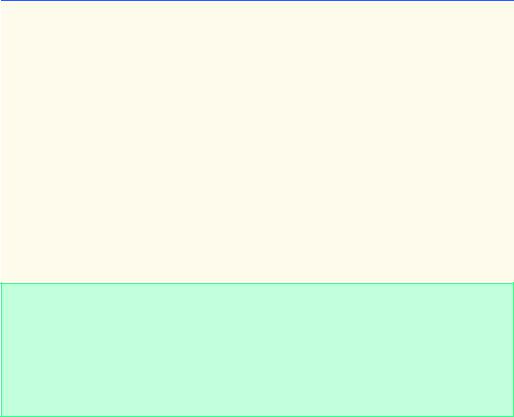
- •Contents
- •Preface
- •Introduction to Computers, the Internet and the Web
- •1.3 Computer Organization
- •Languages
- •1.9 Java Class Libraries
- •1.12 The Internet and the World Wide Web
- •1.14 General Notes about Java and This Book
- •Sections
- •Introduction to Java Applications
- •2.4 Displaying Text in a Dialog Box
- •2.5 Another Java Application: Adding Integers
- •2.8 Decision Making: Equality and Relational Operators
- •Introduction to Java Applets
- •3.2 Sample Applets from the Java 2 Software Development Kit
- •3.3 A Simple Java Applet: Drawing a String
- •3.4 Two More Simple Applets: Drawing Strings and Lines
- •3.6 Viewing Applets in a Web Browser
- •3.7 Java Applet Internet and World Wide Web Resources
- •Repetition)
- •Class Attributes
- •5.8 Labeled break and continue Statements
- •5.9 Logical Operators
- •Methods
- •6.2 Program Modules in Java
- •6.7 Java API Packages
- •6.13 Example Using Recursion: The Fibonacci Series
- •6.16 Methods of Class JApplet
- •Class Operations
- •Arrays
- •7.6 Passing Arrays to Methods
- •7.8 Searching Arrays: Linear Search and Binary Search
- •Collaboration Among Objects
- •8.2 Implementing a Time Abstract Data Type with a Class
- •8.3 Class Scope
- •8.4 Controlling Access to Members
- •8.5 Creating Packages
- •8.7 Using Overloaded Constructors
- •8.9 Software Reusability
- •8.10 Final Instance Variables
- •Classes
- •8.16 Data Abstraction and Encapsulation
- •9.2 Superclasses and Subclasses
- •9.5 Constructors and Finalizers in Subclasses
- •Conversion
- •9.11 Type Fields and switch Statements
- •9.14 Abstract Superclasses and Concrete Classes
- •9.17 New Classes and Dynamic Binding
- •9.18 Case Study: Inheriting Interface and Implementation
- •9.19 Case Study: Creating and Using Interfaces
- •9.21 Notes on Inner Class Definitions
- •Strings and Characters
- •10.2 Fundamentals of Characters and Strings
- •10.21 Card Shuffling and Dealing Simulation
- •Handling
- •Graphics and Java2D
- •11.2 Graphics Contexts and Graphics Objects
- •11.5 Drawing Lines, Rectangles and Ovals
- •11.9 Java2D Shapes
- •12.12 Adapter Classes
- •Cases
- •13.3 Creating a Customized Subclass of JPanel
- •Applications
- •Controller
- •Exception Handling
- •14.6 Throwing an Exception
- •14.7 Catching an Exception
- •Multithreading
- •15.3 Thread States: Life Cycle of a Thread
- •15.4 Thread Priorities and Thread Scheduling
- •15.5 Thread Synchronization
- •15.9 Daemon Threads
- •Multithreading
- •Design Patterns
- •Files and Streams
- •16.2 Data Hierarchy
- •16.3 Files and Streams
- •Networking
- •17.2 Manipulating URIs
- •17.3 Reading a File on a Web Server
- •17.4 Establishing a Simple Server Using Stream Sockets
- •17.5 Establishing a Simple Client Using Stream Sockets
- •17.9 Security and the Network
- •18.2 Loading, Displaying and Scaling Images
- •18.3 Animating a Series of Images
- •18.5 Image Maps
- •18.6 Loading and Playing Audio Clips
- •18.7 Internet and World Wide Web Resources
- •Data Structures
- •19.4 Linked Lists
- •20.8 Bit Manipulation and the Bitwise Operators
- •Collections
- •21.8 Maps
- •21.9 Synchronization Wrappers
- •21.10 Unmodifiable Wrappers
- •22.2 Playing Media
- •22.3 Formatting and Saving Captured Media
- •22.5 Java Sound
- •22.8 Internet and World Wide Web Resources
- •Hexadecimal Numbers

Chapter 9 |
Object-Oriented Programming |
459 |
invoke method toString to append the String representation of the Circle. Lines 39–40 append the area of the Circle to output.
Next, the if/else structure at lines 43–48 attempts a dangerous cast in line 44. We cast point1, which refers to a Point object, to a Circle. If the program attempts to execute this statement, Java would determine that point1 really refers to a Point, recognize the cast to Circle as being dangerous and indicate an improper cast with ClassCastException message. However, we prevent this statement from executing with the if condition
if ( point1 instanceof Circle ) {
that uses operator instanceof to determine whether the object to which point1 refers is a Circle. This condition evaluates to true only if the object to which point1 refers is a Circle; otherwise, the condition evaluates to false. Reference point1 does not refer to a Circle, so the condition fails, and a String indicating that point1 does not refer to a Circle is appended to output.
If we remove the if test from the program and execute the program, the following message is generated at execution time:
Exception in thread "main" java.lang.ClassCastException: Point at InheritanceTest.main(InheritanceTest.java:43)
Such error messages normally include the file name (InheritanceTest.java) and line number at which the error occurred (43) so you can go to that specific line in the program for debugging.
9.5 Constructors and Finalizers in Subclasses
When an object of a subclass is instantiated, the superclass’s constructor should be called to do any necessary initialization of the superclass instance variables of the subclass object. An explicit call to the superclass constructor (via the super reference) can be provided as the first statement in the subclass constructor. Otherwise, the subclass constructor will call the superclass default constructor (or no-argument constructor) implicitly.
Superclass constructors are not inherited by subclasses. Subclass constructors, however, can call superclass constructors via the super reference.
 Software Engineering Observation 9.10
Software Engineering Observation 9.10
 When an object of a subclass is created, first the subclass constructor calls the superclass
When an object of a subclass is created, first the subclass constructor calls the superclass  constructor (explicitly via super or implicitly), the superclass constructor executes, then the remainder of the subclass constructor’s body executes.
constructor (explicitly via super or implicitly), the superclass constructor executes, then the remainder of the subclass constructor’s body executes.
If the classes in your class hierarchy define finalize methods, the subclass finalize method as its last action should invoke the superclass finalize method to ensure that all parts of an object are finalized properly if the garbage collector reclaims the memory for the object.
The application of Fig. 9.7–Fig. 9.9 shows the order in which superclass and subclass constructors and finalizers are called. For the purpose of this example, class Point and class Circle are simplified.
Class Point (Fig. 9.7) contains two constructors, a finalizer, a toString method and protected instance variables x and y. The constructor and finalizer each print that they are executing, then display the Point for which they are invoked. Note the use of
© Copyright 1992–2002 by Deitel & Associates, Inc. All Rights Reserved. 7/7/01

460 Object-Oriented Programming Chapter 9
this in the System.out.println calls to cause an implicit call to method toString. Notice the first line of the finalize method (line 23). Method finalize should always be defined as protected so subclasses have access to the method but classes that simply use Point objects do not.
Class Circle (Fig. 9.8) derives from Point and contains two constructors, a finalizer, a toString method and protected instance variable radius. The constructor and finalizer each print that they are executing, then display the Circle for which they are invoked. Note that the Circle method toString invokes Point’s toString via super (line 19).
 Software Engineering Observation 9.11
Software Engineering Observation 9.11
 When a superclass method is overridden in a subclass, it is common to have the subclass ver-
When a superclass method is overridden in a subclass, it is common to have the subclass ver-  sion call the superclass version and do some additional work. In this scenario, the superclass method performs the tasks common to all subclasses of that class, and the subclass method performs additional tasks specific to a given subclass.
sion call the superclass version and do some additional work. In this scenario, the superclass method performs the tasks common to all subclasses of that class, and the subclass method performs additional tasks specific to a given subclass.
1// Fig. 9.7: Point.java
2// Definition of class Point
3public class Point extends Object {
4 protected int x, y; // coordinates of the Point
5
6 // no-argument constructor
7public Point()
8{
9x = 0;
10y = 0;
11System.out.println( "Point constructor: " + this );
12}
13
14// constructor
15public Point( int xCoordinate, int yCoordinate )
16{
17x = xCoordinate;
18y = yCoordinate;
19System.out.println( "Point constructor: " + this );
20}
21
22// finalizer
23protected void finalize()
24{
25System.out.println( "Point finalizer: " + this );
26}
27
28// convert Point into a String representation
29public String toString()
30{
31return "[" + x + ", " + y + "]";
32}
33
34 } // end class Point
Fig. 9.7 Point class definition to demonstrate when constructors and finalizers are called.
© Copyright 1992–2002 by Deitel & Associates, Inc. All Rights Reserved. 7/7/01

Chapter 9 |
Object-Oriented Programming |
461 |
1// Fig. 9.8: Circle.java
2// Definition of class Circle
3 |
public class Circle extends Point { // inherits from Point |
4 |
protected double radius; |
5 |
|
6 |
// no-argument constructor |
7public Circle()
8{
9// implicit call to superclass constructor here
10radius = 0;
11System.out.println( "Circle constructor: " + this );
12}
13
14// Constructor
15public Circle( double circleRadius, int xCoordinate,
16int yCoordinate )
17{
18// call superclass constructor
19super( xCoordinate, yCoordinate );
20
21radius = circleRadius;
22System.out.println( "Circle constructor: " + this );
23}
24
25// finalizer
26protected void finalize()
27{
28System.out.println( "Circle finalizer: " + this );
29super.finalize(); // call superclass finalize method
30}
31
32// convert the Circle to a String
33public String toString()
34{
35return "Center = " + super.toString() +
36 |
"; Radius = " + radius; |
37 |
} |
38 |
|
39 |
} // end class Circle |
Fig. 9.8 Circle class definition to demonstrate when constructors and finalizers are called.
Common Programming Error 9.5

 When an overridden method calls the superclass version of the same method, not using key-
When an overridden method calls the superclass version of the same method, not using key-  word super to reference the superclass’s method causes infinite recursion, because the subclass method actually calls itself.
word super to reference the superclass’s method causes infinite recursion, because the subclass method actually calls itself.
Common Programming Error 9.6

 Cascading super reference to refer to a member (method or variable) several levels up the
Cascading super reference to refer to a member (method or variable) several levels up the  hierarchy (as in super.super.x) is a syntax error.
hierarchy (as in super.super.x) is a syntax error.
© Copyright 1992–2002 by Deitel & Associates, Inc. All Rights Reserved. 7/7/01

462 |
Object-Oriented Programming |
Chapter 9 |
Application class Test (Fig. 9.9) uses this Point/Circle inheritance hierarchy. The application begins in method main by instantiating Circle object circle1 (line 11). This invokes the Circle constructor at line 15 of Fig. 9.8, which immediately invokes the Point constructor at line 15 of Fig. 9.7. The Point constructor outputs the values received from the Circle constructor by implicitly calling method toString and returns program control to the Circle constructor. Then the Circle constructor outputs the complete Circle by calling method toString. Notice that the first two lines of the output from this program both show values for x, y and radius. Polymorphism is once again causing the Circle’s toString method to execute because it is a Circle object that is being created. When toString is invoked from the Point constructor, 0.0 is displayed for the radius because the radius has not yet been initialized in the Circle constructor.
Circle object circle2 is instantiated next. Again, the Point and Circle constructors both execute. Notice, in the command-line output window, that the body of the Point constructor is performed before the body of the Circle constructor, showing that objects are constructed “inside out.”
1// Fig. 9.9: Test.java
2 // Demonstrate when superclass and subclass
3 // constructors and finalizers are called.
4 public class Test {
5
6 // test when constructors and finalizers are called
7public static void main( String args[] )
8{
9 Circle circle1, circle2;
10
11circle1 = new Circle( 4.5, 72, 29 );
12circle2 = new Circle( 10, 5, 5 );
13
14circle1 = null; // mark for garbage collection
15circle2 = null; // mark for garbage collection
17 |
System.gc(); |
// call the garbage collector |
18 |
} |
|
19 |
|
|
20 |
} // end class Test |
|
Point constructor: Center = [72, 29]; Radius = 0.0
Circle constructor: Center = [72, 29]; Radius = 4.5
Point constructor: Center = [5, 5]; Radius = 0.0
Circle constructor: Center = [5, 5]; Radius = 10.0
Circle finalizer: Center = [72, 29]; Radius = 4.5
Point finalizer: Center = [72, 29]; Radius = 4.5
Circle finalizer: Center = [5, 5]; Radius = 10.0
Point finalizer: Center = [5, 5]; Radius = 10.0
Fig. 9.9 Order in which constructors and finalizers are called.
© Copyright 1992–2002 by Deitel & Associates, Inc. All Rights Reserved. 7/7/01
